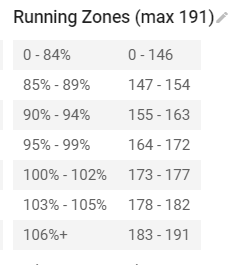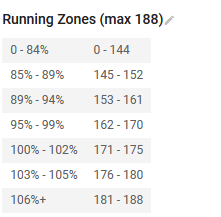I am a bit new to this, but I love the site for tracking my overall TSS from mixed activities. I noticed the TSS values for running seem to be off significantly from Garmin/Training Peaks/Strava, for example I did a run this week an Intervals.icu has a TSS of 49 vs Training Peaks of 108, this has been consistent for the few treadmill runs I have done. Cycling activities seem to correlate much closer so I am not sure if there is a significant difference in how running activities are calculated? or perhaps because I am using a Stryd and have power data that is throwing the calculations off?
Can you double check your Intervals.icu > Running Zones? 
Btw are you sure your TP value is correct for TSS? What run activity was, duration?
I believe running zones are setup correctly, and this may just be a difference in how they are calculated. My TP is pretty much the same values ± a couple bpm. That doesn’t mean my TP TSS value is correct, but for cycling activities they do correlate much closer. If I change TP to use hrTSS instead of TSS it is closer, 56 instead of 108, so this very likely could just be me.

By default TP calculates rTSS based on your threshold pace (best pace you can maintain for 1 hour). So first thing to check would be what does TP think your threshold pace is. Also TP then converts that to a gradient adjusted pace. So if you’re running on a treadmill and depending on how your gradient is measured then that might also throw it off. Not sure if TP does some gradient profile adjustment first but from experience garmins that don’t have a barometer for measuring altitude give shocking results!
I run with a Stryd power meter, couple of other things I’ve noticed I’ve just noticed. TP appears to use that as a power source and calculate TSS based on that (I can get a TSS and rTSS value). I didn’t realise this and so was based on my cycling FTP which is about 70W lower than my running FTP, hence TP giving me a high TSS. I’ve now added a run specific FTP so will be interesting to see what happens on tomorrow’s run. Also if the elevation profile in TP is to be believed then its from my FR735, which is shocking, and annoying as the Stryd gives a good elevation profile (has a barometer) but is only used for internal calcs and doesn’t get pushed to your watch to overwrite what your watch is measuring.
Also remember most power based metrics on TP are based on NP which is a 30s smoothing of your power.
@John_Peters_endura.f I think that is largely my problem, I run with a Stryd as well and have a similar delta for my cycling FTP and running FTP. I created some running power zones and that changed the TSS from 108 to 73.
Yeah I’ve just made a similar change and now when I go back into my last couple of runs and cycle through the TSS options to force a recalculate it comes out closer to what I was expecting.
New feature request for Intervals.ecu → Running Power Zones 
That has been on the list for a long time. I need to do a big batch of running power stuff soon (power curves and so on). Quite a lot of work to separate everything out by sport everywhere.
Intervals.icu will use HRSS to estimate load for your runs and ignore the Stryd power. Thats probably why it is a lot different to TP.
With updated run specific settings in TP this morning’s TSS aligns with what I calculated independently (~42). HRSS in TP and intervals.icu also align (~29) so everything as expected. As an aside, I’ve noticed over the last year that HR based Load scores always comes out a bit lower than Power based Load scores (but that might just be me).
Tx for this! I suppose its easier to sell running foot pods if they make it look like you are working harder 
I dont get running with a power meter. I am coming to cycling from a running background and have quickly realised the value of a power meter in cycling. I cant imagine ever wanting to use one for running or any real benefit it would add.
I would think perceived effort and heart rate (if you must), are much better indicators. Personally I run on how I feel and think a power meter would be likely to hold me back some days and push me on on other days.
Pace and perceived effort are more than enough for me. I look at my heart rate after a run but pay it no heed at all during running. That said I can see its use for many people.
Hope this does not seem confrontational. I don’t get it but that does not mean its not right for some.
I would be interested to hear why people use them and the logic led to the decision? Are you former cyclists used to using power as a pacing/effort guide?
I’m a runner who only got into cycling (Zwift) this time last year when all running competition stopped, so it was something else to do and get in the odd race. I really enjoyed the cycling training/racing concept of using power (who looks at pace/speed on Zwift?), so this year is an experiment to run train by power and HR. I haven’t got into any serious sessions yet so still to see how interval and threshold sessions will go when trying to hold a power rather than a pace, but it has been useful as another indicator to hold back on my easy runs.
Plus I’m a data analyst so its more data for me to play with 
Are you training on a treadmill then? If so I get it. If not its still all valid just probably not something for me.
Interesting though.
Good luck with the training!
Thanks. All road and trail round the Sussex downs at the moment. Hoping to get back on a track this year!
I just stalked you on Strava, mainly because I am strange but partly because I was interested in where you were running. I have ran a bit in the downs over the years.
I noticed on one run you mentioned your knee holding up. What has happened there? I had an arthroscopy around six weeks ago (14th Jan)and started running about ten days ago. I only did a mile three times but started to get some discomfort and have rested since. Thats about a week. I plan to start again next Monday again with a mile. I would be interested to know what happened to your knee and how the recovery was.
 not sure what happen with my knee. Just started getting a pain above my right kneecap. Came on during a run. Have reverted back to 3 runs 3 rides per week keeping it LIT for the next few weeks (although I did try a couple of strides today). Probably just age. But recovery has been just rest and then more weeks at low intensity than you really want to.
not sure what happen with my knee. Just started getting a pain above my right kneecap. Came on during a run. Have reverted back to 3 runs 3 rides per week keeping it LIT for the next few weeks (although I did try a couple of strides today). Probably just age. But recovery has been just rest and then more weeks at low intensity than you really want to.
I think in theory like a cycling power meter you can better pace yourself for hills and such since power is instantaneous and your HR could lag burning you out faster. I personally bought the Stryd primarily because it is one of the most accurate foot pod out there for measuring pace and distance, my Garmin GPS watch was always inconsistent for pace and my treadmill is not very accurate at all. The power data is just more fun numbers to look at and maybe this summer I see if the power numbers have any real use for me.
Good luck with it @Jared_H. I am certainly not against it. I think its quite interesting and I do like data.
What do they cost?
I have a Polar watch with running power, and it’s a problem if I use that to calculate load as it overestimates power compared with cycling at the same effort, by anywhere between 10 and 20%. As far as I know there is no agreement on how to calculate running power, and I believe that it generally reads ~10% higher than Stryd or Garmin (from several DCRainmaker posts). I find that for running hrTss works much better for me.
I hope you find it more useful than I do…